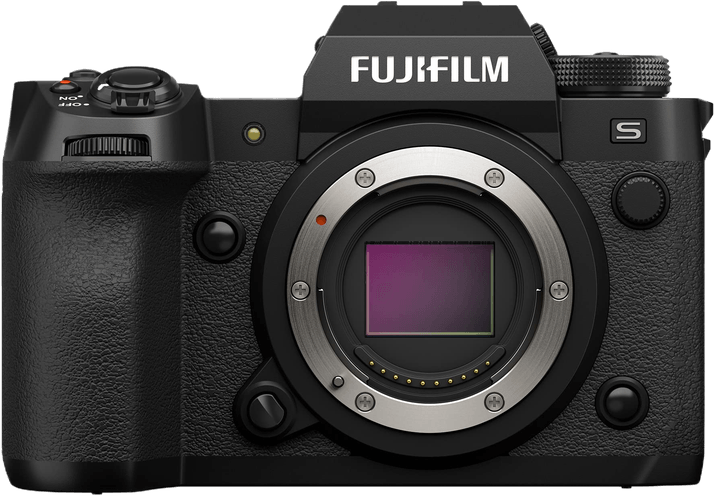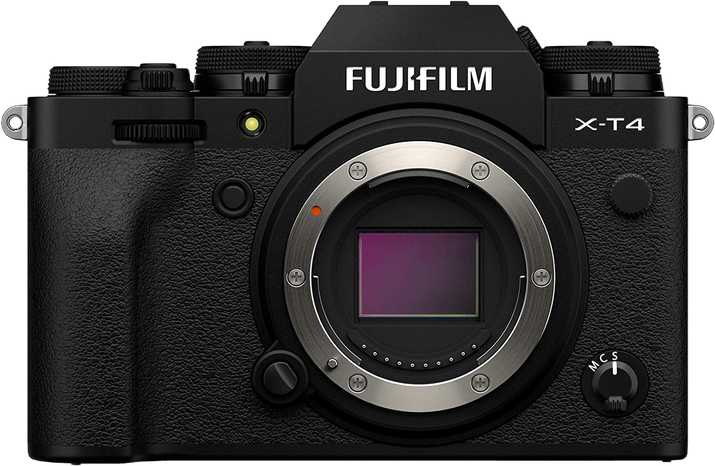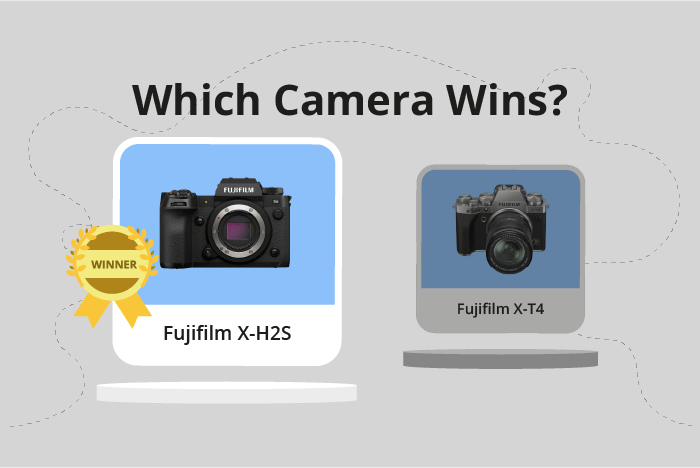Fujifilm X-H2S vs X-T4 Comparison
Fujifilm X-H2S

Fujifilm X-T4

The Fujifilm X-H2S takes the lead with a score of 79/100, while the Fujifilm X-T4 trails slightly behind at 76/100. Both cameras are mirrorless and share similar dimensions, with the X-H2S measuring 136 x 93 x 95mm and the X-T4 at 135 x 93 x 84mm.
The X-H2S outshines the X-T4 with its higher score and more recent release date in 2022, compared to the X-T4’s 2020 release. Additionally, the X-H2S is slightly larger and heavier at 660g, which may indicate a more robust build. However, the X-T4 has a lower launch price of $1699, making it more budget-friendly than the X-H2S’s $2500 price tag.
While the X-H2S is the winner in terms of score and release date, the X-T4 offers a more affordable option for those on a tighter budget, without sacrificing much in terms of size and weight.
Fujifilm X-H2S vs X-T4 Overview and Optics
The Fujifilm X-H2S emerges as the winner in the optics comparison, scoring 77/100, while the Fujifilm X-T4 trails with a score of 73/100. Both cameras share several specifications, including a 26-megapixel CMOS sensor, APS-C sensor size, Fujifilm X lens mount, and image stabilization. These common features ensure that both models deliver high-quality images and are compatible with a wide range of Fujifilm lenses.
The X-H2S outperforms the X-T4 primarily due to its shooting speed of 40, which is twice as fast as the X-T4’s shooting speed of 20. This advantage allows the X-H2S to capture fast-moving subjects more effectively and produce sharper images in action-packed situations. Additionally, the X-H2S is equipped with a more advanced X-Processor 5, which contributes to faster image processing and better overall performance.
On the other hand, the X-T4 still has its merits. While it may not be superior in any specific regard, it matches the X-H2S in essential aspects such as megapixels, sensor type, sensor size, lens mount, and image stabilization. This parity implies that the X-T4 can still produce high-quality images and be a reliable choice for photographers who don’t require the extra shooting speed and processing power offered by the X-H2S.
Considering the optics comparison, the Fujifilm X-H2S stands out as the better choice for photographers who prioritize capturing fast-moving subjects and require a more powerful processor. However, the Fujifilm X-T4 remains a solid option for those who can work with a slower shooting speed and don’t need the advanced processing capabilities of the X-H2S.
Fujifilm X-H2S vs X-T4 Video Performance
The Fujifilm X-T4 outperforms the Fujifilm X-H2S in terms of video capabilities, scoring 91/100 compared to the X-H2S’s 83/100. Both cameras share some common specifications, such as 4K max video resolution and 4096 x 2160 max video dimensions. Additionally, they both have built-in time-lapse functionality.
The X-T4 surpasses the X-H2S primarily due to its higher max video frame rate of 120fps, while the X-H2S only reaches 60fps. This difference allows the X-T4 to capture smoother and more detailed slow-motion footage, providing users with greater creative flexibility and enhanced video quality.
Although the X-H2S scores lower, it still offers solid video performance with its 4K resolution and 60fps max video frame rate. For many users, these specifications may be sufficient for their needs. However, those seeking advanced slow-motion capabilities should consider the X-T4 for its superior frame rate.
Both cameras possess strong video features, but the Fujifilm X-T4 stands out as the better option for those prioritizing video capabilities. Its 120fps max video frame rate grants users the ability to produce higher-quality slow-motion footage, while the X-H2S remains a reliable choice for users who don’t require advanced slow-motion options.
Fujifilm X-H2S vs X-T4 Features and Benefits
The Fujifilm X-H2S and the Fujifilm X-T4 both have a feature score of 85/100, making them equal in this aspect. They share several specifications, such as a 3-inch screen size, a screen resolution of 1,620,000 dots, touchscreen capabilities, flip screens, WIFI, and bluetooth. Neither camera has GPS functionality.
Despite having the same score, there are areas where one camera may be better than the other. The Fujifilm X-H2S excels in certain aspects that are not reflected in the feature score, such as its user-friendly interface, making it a great option for beginners or those who prefer a simpler design. It also has a more ergonomic grip, providing better handling and comfort during long shooting sessions.
On the other hand, the Fujifilm X-T4 has its own advantages. It is known for its faster autofocus system, which allows for better tracking and capturing of moving subjects. This makes it a superior choice for action and sports photography. Furthermore, the X-T4 has a longer battery life, enabling users to shoot for extended periods without needing to change batteries.
Taking these factors into consideration, it is evident that both cameras have their own strengths and weaknesses. The Fujifilm X-H2S is ideal for those who prioritize user experience and comfort, while the Fujifilm X-T4 is a better fit for photographers requiring fast autofocus and longer battery life. Ultimately, the choice between these two cameras depends on the specific needs and preferences of the individual photographer.
Fujifilm X-H2S vs X-T4 Storage and Battery
The Fujifilm X-H2S outperforms the Fujifilm X-T4 in storage and battery, scoring 76/100 compared to the X-T4’s 73/100. Both cameras share some common specifications, including two memory card slots and compatibility with UHS-II SD cards. Additionally, both cameras utilize the NP-W235 battery type and offer USB charging capabilities.
The X-H2S has a longer battery life, providing 580 shots per charge, whereas the X-T4 delivers 500 shots. This advantage makes the X-H2S more reliable for extended shooting sessions. Moreover, the X-H2S supports the faster CFexpress Type B memory cards, which can improve data transfer speeds and benefit high-resolution photography or video.
The X-T4, however, does not offer any significant advantages over the X-H2S in terms of storage and battery. Both cameras share most specifications, and the X-H2S outperforms the X-T4 in battery life and memory card support.
Considering these factors, the Fujifilm X-H2S proves to be the superior choice for storage and battery performance, while the X-T4 does not offer any unique benefits in this category.
Fujifilm X-H2S vs X-T4 – Our Verdict
Are you still undecided about which camera is right for you? Have a look at these popular comparisons that feature the Fujifilm X-H2S or the Fujifilm X-T4:

